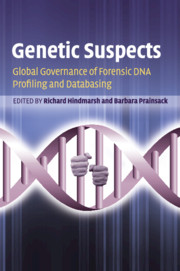Book contents
- Frontmatter
- Contents
- List of contributors
- About the contributors
- Foreword
- Acknowledgements
- 1 Introducing Genetic Suspects
- Section 1 Key areas in DNA profiling and databasing
- Section 2 National contexts of forensic DNA technologies and key issues
- 7 DNA databases and the forensic imaginary
- 8 Partners in crime: the use of forensic DNA technologies in Austria
- 9 Inquisitorial forensic DNA profiling in the Netherlands and the expansion of the forensic genetic body
- 10 DNA the Nor-way: black-boxing the evidence and monopolising the key
- 11 Portuguese forensic DNA database: political enthusiasm, public trust and probable issues in future practice
- 12 On trial! Governing forensic DNA technologies in the USA
- 13 Biosurveillance and biocivic concerns, from ‘truth’ to ‘trust’: the Australian forensic DNA terrain
- 14 Finding the balance: forensic DNA profiling in New Zealand
- 15 Forensic DNA profiling and databasing: the Philippine experience
- Section 3 Conclusions
- Index
- References
13 - Biosurveillance and biocivic concerns, from ‘truth’ to ‘trust’: the Australian forensic DNA terrain
from Section 2 - National contexts of forensic DNA technologies and key issues
Published online by Cambridge University Press: 05 October 2012
- Frontmatter
- Contents
- List of contributors
- About the contributors
- Foreword
- Acknowledgements
- 1 Introducing Genetic Suspects
- Section 1 Key areas in DNA profiling and databasing
- Section 2 National contexts of forensic DNA technologies and key issues
- 7 DNA databases and the forensic imaginary
- 8 Partners in crime: the use of forensic DNA technologies in Austria
- 9 Inquisitorial forensic DNA profiling in the Netherlands and the expansion of the forensic genetic body
- 10 DNA the Nor-way: black-boxing the evidence and monopolising the key
- 11 Portuguese forensic DNA database: political enthusiasm, public trust and probable issues in future practice
- 12 On trial! Governing forensic DNA technologies in the USA
- 13 Biosurveillance and biocivic concerns, from ‘truth’ to ‘trust’: the Australian forensic DNA terrain
- 14 Finding the balance: forensic DNA profiling in New Zealand
- 15 Forensic DNA profiling and databasing: the Philippine experience
- Section 3 Conclusions
- Index
- References
Summary
INTRODUCTION
Bloodstains were used to establish a crime or provide corroborating evidence as early as 384 ad (New South Wales Ombudsman 2001: 5). In the modern era, that procedure was significantly advanced in 1901 by the Austrian medical researcher and later American Nobel Prize winner Karl Landsteiner. He discovered antigens in the blood, which led to the classification of what we know as the ABO blood group system. While the first and obvious benefit of this system was to avoid death from transfusion and thus to make surgery safer, it also occurred to Landsteiner that this classification could be used for forensic purposes. But it was not until 1985 that (UK) police first used blood – along with semen, saliva, other body fluids and hair – for forensic DNA profiling, after it was discovered that individuals could be identified from DNA by restriction fragment length polymorphism (RFLP) (Jeffreys et al. 1985a, 1985b).
In 1988, English baker Colin Pitchfork was the first person convicted of murder through the use of DNA evidence. In the same case, suspect Richard Buckland became the first person to have innocence established by DNA evidence (Sanders 2000). However, this method of profiling did not involve DNA amplification and, therefore, required a relatively large amount of DNA – 25 or more hairs or a cent-sized bloodstain – the fresher the better. This could be a drawback in criminal cases, where DNA is often taken from human tissues degraded or contaminated by exposure.
- Type
- Chapter
- Information
- Genetic SuspectsGlobal Governance of Forensic DNA Profiling and Databasing, pp. 262 - 287Publisher: Cambridge University PressPrint publication year: 2010
References
- 2
- Cited by



